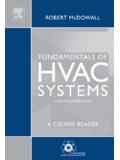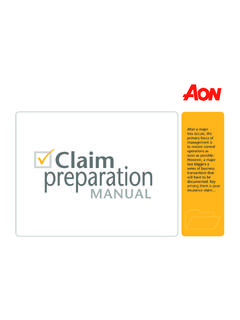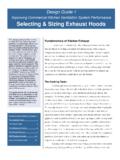Transcription of Preface W - ashraerp.com
1 Preface What would the world look like without ASHRAE Research? Since its beginnings in 1919, ASHRAE Research has grown and expanded to address the ever changing questions and topics facing both its members and the HVAC&R Industry and the world as a whole. The ASHRAE. Handbook is constantly evolving to address these new challenges, fueled by the knowledge and principals developed through ASHRAE Research. As the focus of the industry has evolved from home refrigeration and food safety to improved indoor air quality to sustainability and energy efficiency, this four-volume series continues to be the cornerstone in every ASHRAE. Member's career. The power behind ASHRAE Research and the four-volume Handbook comes directly from YOU: your financial support is the driving force behind every research project conducted world wide;. your financial investment is an investment in the future of the HVAC&R industry; your donation to ASHRAE Research fills the more than 3,600 Handbook pages.
2 What would the ASHRAE Handbook look like without your support of ASHRAE Research? Take a look at just one chapter and imagine a world without this guidance from ASHRAE over the last 90 years. Research Promotion Committee Reprinted and altered with the written permission of ASHRAE and for chapter distribution only. The publication may not be reproduced without permission from ASHRAE Research Promotion Staff. Patricia Adelmann, Manager RP 404/636-8400, ext. 1114 or 1791 Tullie Circle, Atlanta GA 30329. CHAPTER 18. NONRESIDENTIAL COOLING AND HEATING. LOAD CALCULATIONS. Cooling Load Calculation Principles .. Heating Load Calculations .. Internal Heat Gains .. System Heating and Cooling Load Effects .. Infiltration and Moisture Migration Heat Gains .. Example Cooling and Heating Load Fenestration Heat Gain .. Calculations .. Heat Balance Method.
3 Previous Cooling Load Calculation Methods .. Radiant Time Series (RTS) Method .. Building Example Drawings .. H EATING and cooling load calculations are the primary design basis for most heating and air-conditioning systems and com- ponents. These calculations affect the size of piping, ductwork, dif- and possibly direction, d uring a 24 h period. Because these cyclic changes in load components often are not in phase with each other, each component must be analyzed to establish the maximum cool- fusers, air handlers, boilers, chille rs, coils, compressors, f ans, and ing load for a building or zone. A zoned system ( , one serving every other component of systems that condition indoor environ- several independent areas, each w ith its own temperature control). ments. Cooling and heating load calculations can significantly affect needs to provide no greater total cooling load capacity than the larg- first cost of building construction, comfort and productivity of occu- est hourly sum of simultaneous zone loads throughout a design day.
4 Pants, and operating cost and energy consumption. however, it must handle the peak c ooling load for each zone at its Simply put, heating and cooling loads are the rates of energy in- individual peak hour. At some times of day during heating or inter- put (heating) or remo val (cooling) required to maintain an indoor mediate seasons, some zones ma y requ ire heatin g while others environment at a desired temperature and humidity condition. Heat- require cooling. The zones' v entilation, h umidification, or deh u- ing and air conditioning systems are designed, sized, and controlled midification needs must also be considered. to accomplish that energy transfer. The amount of heating or cooling required at any particular time varies widely, depending on external Heat Flow Rates ( , outside temperature) and internal ( , number of people oc- In air-conditioning design, the following four related heat flow cupying a space) factors.
5 Rates, each of which varies with time, must be differentiated. Peak design heating and cooling load calculations, which are this Space Heat Gain. This instantaneous rate of heat gain is the rate chapter's focus, seek to determine the maximum rate of heating and at which heat enters into and/or is gen erated within a spac e. Heat cooling energy transfer needed at any point in time. Similar princi- gain is classified by its mode of entry into the space and whether it ples, but with different assumptions, data, and application, can be is sensi ble or la tent. Entry modes include (1) solar radiation used to estimate b uilding energy con sumption, as described in through transparent surfaces; (2) heat conduction through exterior Chapter 19. walls and ro ofs; (3) heat conduction through ceilings, floor s, and This chapter discusses common elements of cooling load calcu- interior p artitions; ( 4) heat generated in the spac e by occupants, lation ( , internal heat gain, ventilation and infiltration, moisture lights, and appliances; (5) energy transfer through direct-with-space migration, fenestration heat gain) and two methods of heating and ventilation and inf iltration of out door air; and (6) miscellaneous cooling load estimation: heat balance (HB) and radiant time series heat gains.
6 Sensible heat is added directly to the conditioned space (RTS). by conductio n, con vection, an d/or r adiation. Latent heat ga in occurs when moisture is added to the space ( , from vapor emitted by occupants and equipment). T o maintain a constant hum idity COOLING LOAD CALCULATION ratio, water vapor must condense on the cooling apparatus and be PRINCIPLES removed at the same rate it is added to the space. The amount of energy required to offset latent heat gain essentially equals the prod- Cooling loads result from many conduction, convection, and radi- uct of the condensation rate and latent heat of condensation. In ation heat transfer processes through the building envelope and from selecting cooling equ ipment, di stinguish between sensible and internal sources and system components. Buildi ng comp onents or latent he at g ain: every cooling apparatus has different maximum contents that may affect cooling loads include the following: removal capacities for sensible versus latent heat for particular oper- External: Walls, roofs, windo ws, sk ylights, door s, partitio ns, ating conditions.
7 In extremely dry climates, humidification may be ceilings, and floors required, rather than dehumidification, to maintain thermal comfort. Internal: Lights, people, appliances, and equipment Radiant Heat Gain. Radiant energy must first be absorbed by sur- Infiltration: Air leakage and moisture migration faces that enclose the space (walls, floor, and ceiling) and objects in System: Outside air, duct leakage and heat gain, reheat, fan and the space (furniture, etc.). When these surfaces and objects become pump energy, and energy recovery warmer than the surrounding air, some of their heat transfers to the air by convection. The composite heat storage capacity of these sur- TERMINOLOGY faces and objects determines the rate at which their respec tive sur- face temperatures increase for agiven radiant input, and thus governs The variables affecting cooling load calculations are numerous, the relationship between the radiant portion of heat gain and its cor- often dif ficult to def ine precisely, and al ways intr icately int erre- responding part o f the space cooling load (Figure 1).
8 The therma l lated. Many cooling load components vary wid ely in magnitude, storage effect is critical in differentiating between instantaneous heat gain for a given space and its cooling load at that moment. Predicting The pr eparation of this chapter is a ssigned to T C , Load C alculation the nature and magnitude of this phenomenon in order to estimate a Data and Procedures. realistic cooling load for a particular set of circumstances has long 2009 ASHRAE Handbook fundamentals Fig. 1 Origin of Difference Between Magnitude of Instanta- neous Heat Gain and Instantaneous Cooling Load Fig. 2 Thermal Storage Effect in Cooling Load from Lights Fig. 1 Origin of Difference Between Magnitude of Instantaneous Heat Gain and Instantaneous Cooling Load Fig. 2 Thermal Storage Effect in Cooling Load from Lights been of inter est to design engineers; the Bibliogr aphy lists some Cooling load calculation of an ac tual, mul tiple-room b uilding early work on the subject.
9 Requires a complex computer program implementing the principles Space Cooling Load. This is the rate at which sensible and latent of either method. heat must be removed from the space to maintain a constant space air temperature and humidity. The sum of all space instantaneous Cooling Load Calculations in Practice heat gains at an y gi ven time doe s not necessarily (or e ven fre- Load calculations sh ould accurately descri be the building. All quently) equal the cooling load for the space at that same time. load calculation inputs should be as accurate as reasonable, without Space Heat E xtraction Rate. The rates at which sensible and using safety f actors. Introd ucing compounding safety f actors at latent heat are removed from the conditioned space equal the space multiple levels in the load calculation results in an unrealistic and cooling load only if the room air temperature and humidity are con- oversized load.
10 Stant. Along with the intermittent operation of cooling equipment, Variation in h eat tra nsmission coe fficients of typ ical b uilding control systems usually allow a minor cyclic variation or swing in materials and com posite a ssemblies, dif fering moti vations and room temperature; humidity is often allowed to float, but it can be skills of those who construct the building, unknown filtration rates, controlled. Therefore, proper simulation of the control system gives and the manner in which the building is actually operated are some a more realistic value of energy removal over a f ixed period than of the variables that make precise calculation impossible. Ev en if using values of the space cooling load. However, this is primarily the designer uses reasonable procedures to account for these factors, important for esti mating energy use over time; it is not needed to the calculation can never be more than a good estimate of the actual calculate design peak cooling load for equipment selection.







